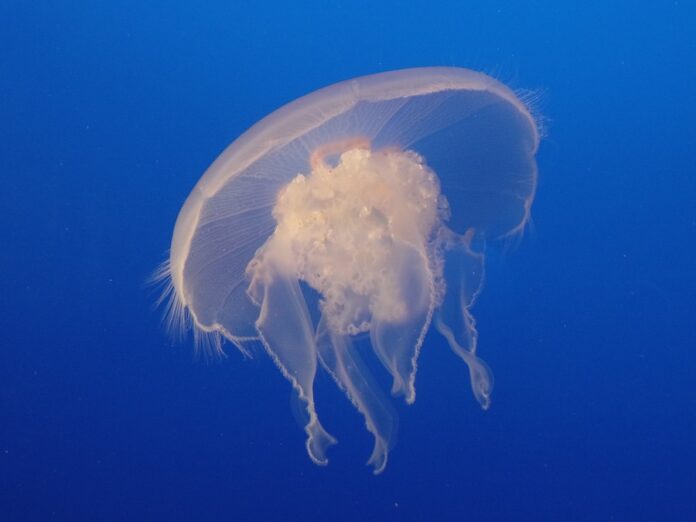Research gives rise to evidence suggestive of early cnidarian history
Jellyfish have a more complicated life cycle compared to their relatives, some of which include sea anemones and corals, so one may assume that they have a more complex genetic composition as well. Recent research, however, suggests that this may not be the case. The research, led by David Gold, an associate professor in the Department of Earth and Planetary Sciences at UC Davis, sequenced the genome of the jellyfish Aurelia, and found evidence that an increase in life history complexity in cnidarians does not necessarily correlate with an increase in gene number.
Before coming together to sequence its genome, Gold explained that the authors of the paper had been individually interested in the various aspects of the Aurelia, a genus of scyphozoan jellyfish.
Ralph Greenspan, the associate director of the Kavli for Brain and Mind at UC San Diego, wanted to study the function of the jellyfish’s nervous system in behavior using genetic manipulations. According to Rob Steele, a professor at UC Irvine, Greenspan reached out to Steele, due to his background in sequencing the hydra genome, along with Gold and David Jacobs, who were UCLA graduate students at the time studying the Aurelia. Gold stated that he was interested in the jellyfish’s ability to regenerate and grow new tissue.
Steele explained that Takeo Katsuki, a post doctorate at Greenspan’s lab, grew the Aurelia and made the DNA in order for it to be sequenced. This process took over six years to complete, explained Gold. Part of this was because the team was required to look through a lot of data since genome itself is about 700 megabases long. In addition, Steele said that when assembling the genome, sequences could potentially be too short to form continuous stretches of sequence, or heterozygosity in the genomes could differ and interfere with the assembling process.
“Assembling genomes is not as straightforward as some people might guess,” Steele said. “I think in general people think you get the sequences, you throw them into a computer, you push a button and out comes the assembled genome. And that’s not quite [the] way it is.”
Once the genome was sequenced and able to be analyzed, the researchers had expected to see DNA more complicated than that of sea anemones or corals, which are unable to swim around as a jellyfish does. However, they found that the medusa stage, where the jellyfish develop their ability to swim, does not require new genes. Instead, the stage is comprised with classes of genes already present in nematostella (a genus of sea anemones).
“We were surprised to find out that really wasn’t the case, that the jellyfish was able to keep its genome, keep its DNA very simple, very similar to its relatives, and still build a very different kind of animal with similar genes and similar types of DNA,” Gold said.
According to Gold, there are a couple ways that the researchers could interpret this data. One possibility would be that animals could evolve from being simple and sedentary, like a sea anemone, to an animal like a swimming jellyfish without large changes within the DNA. Alternatively, it could be argued that the cnidarian ancestors were originally more complicated and eventually simplified their DNA. Steele stated that there are many examples within biology of structures being lost, and the question comes down to whether complexity is built up or simplified over time.
“Humans tend to think ‘well of course you start simple and then you get more complex cause that’s how we view things usually.’ You start out with bicycles and you eventually end up with cars,” Steele said. “But biology doesn’t engineer the way we as humans do, so it’s perfectly reasonable to think that something started out, or at least early on, was more complex than it is now.”
He further suggested a potential experiment that could be done to test these hypotheses: taking genes from the Aurelia that could possibly contribute to the medusa stage and transferring them into a cnidarian that does not have a medusa stage to see its effects. In doing so, they could test what would happen if a gene were to be replaced in an animal that had potentially lost it. Gold added that more data of sequenced genomes of other species would help contribute to their understanding of cnidarian history.
Greenspan said that there is significant value in research that asks the basic questions of biology. Even if the research does not have any current, practical application, he believes that expanding the knowledge on genomes and evolutions is a value in and of itself. Steele commented that he calls themselves ‘knowledge creators’ who are motivated by curiosity and the will to understand something in greater detail.
“This is not going to impact your health in any obvious way at this point. It’s not going to necessarily solve the climate change problem. But it’s something we’re curious about and we want to know the answer,” Steele said. “I think people don’t appreciate that a lot of science is just people asking interesting questions and trying to get the answer. Sometimes you get unexpected things that are useful or important, and I also tell people that all the stuff you read about in your textbooks in your biology class didn’t just fall out of the sky. Those facts in those textbooks came from people like us just asking questions and trying to get the answers.”
Written by: Michelle Wong — science@theaggie.org




